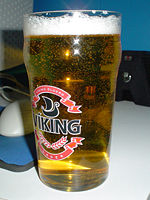Portal:Drink
|
D r i n k A portal dedicated to all beverages |
|||||||||||||||||||||||||||||||||||||||||
The Drink Portal
A drink, in this case a glass of port wine.
Drinks, or beverages, are liquids specifically prepared for human consumption. In addition to basic needs, beverages form part of the culture of human society. Despite the fact that most beverages, including juice, soft drinks, and carbonated drinks, have some form of water in them; water itself is often not classified as a beverage, and the word beverage has been recurrently defined as not referring to water. Essential to the survival of all organisms, water has historically been an important and life-sustaining drink to humans. Excluding fat, water composes approximately 70% of the human body by mass. It is a crucial component of metabolic processes and serves as a solvent for many bodily solutes. Health authorities have historically suggested at least eight glasses, eight fluid ounces each, of water per day (64 fluid ounces, or 1.89 litres), and the British Dietetic Association recommends 1.8 litres. The United States Environmental Protection Agency has determined that the average adult actually ingests 2.0 litres per day. Distilled (pure) water is rarely found in nature. Spring water, a natural resource from which much bottled water comes, is generally imbued with minerals. Tap water, delivered by domestic water systems in developed nations, refers to water piped to homes through a tap. All of these forms of water are commonly drunk, often purified through filtration. An alcoholic beverage is a drink containing ethanol, commonly known as alcohol, although in chemistry the definition of an alcohol includes many other compounds. Alcoholic beverages, such as wine, beer, and liquor have been part of human culture and development for 8,000 years. Non-alcoholic beverages often signify drinks that would normally contain alcohol, such as beer and wine but are made with less than .5 percent alcohol by volume. The category includes drinks that have undergone an alcohol removal process such as non-alcoholic beers and de-alcoholized wines. Drink and Beverage WikiProjectsWikiProject Food & Drink is an association of Wikipedians with an interest in culinary-related subjects. They have come together to co-ordinate the development of food and drink articles here on Wikipedia as well as the many subjects related to food such as foodservice, catering and restaurants. If you wish to learn more about these subject as well as get involved, please visit the Food & Drink Wikiproject page to see how you can help! Beyond the general culinary interests, several groups of Wikipedians have banded together for beverage-specific projects covering their favorite types of drinks. If any of these subjects pique your interest, please feel free to visit their projects. These groups would love you to have you participate!
Selected article
Selected person
Selected ingredient
Rice is the seed of the monocot plant Oryza sativa, of the grass family (Poaceae). As a cereal grain, it is the most important staple food for a large part of the world's human population, especially in tropical Latin America, East, South and Southeast Asia. It is the grain with the second highest worldwide production, after maize ("corn").
Since a large portion of maize crops are grown for purposes other than human consumption, rice is probably the most important grain with regards to human nutrition and caloric intake, providing more than one fifth of the calories consumed worldwide by our species. A traditional food plant in Africa, rice has the potential to improve nutrition, boost food security, foster rural development and support sustainable landcare. In early 2008, some governments and retailers began rationing supplies of the grain due to fears of a global rice shortage. The name wild rice is usually used for species of the grass genus Zizania, both wild and domesticated, although the term may also be used for primitive or uncultivated varieties of Oryza. Rice is normally grown as an annual plant, although in tropical areas it can survive as a perennial and can produce a ratoon crop for up to 20 years. The rice plant can grow to 1–1.8 m tall, occasionally more depending on the variety and soil fertility. The grass has long, slender leaves 50–100 cm long and 2–2.5 cm broad. The small wind-pollinated flowers are produced in a branched arching to pendulous inflorescence 30–50 cm long. The edible seed is a grain (caryopsis) 5–12 mm long and 2–3 mm thick. Rice cultivation is well-suited to countries and regions with low labor costs and high rainfall, as it is very labor-intensive to cultivate and requires plenty of water for cultivation. On the other hand, mechanized cultivation is extremely oil-intensive, more than other food products with the exception of beef and dairy products. Rice can be grown practically anywhere, even on a steep hill or mountain. Although its parent species are native to South Asia and certain parts of Africa, centuries of trade and exportation have made it commonplace in many cultures worldwide. Drink newsDrink news from Wikinews · Help write more articles!
Selected quote
Did you know...Selected pictureA wine cellar in Žlebské Chvalovice in the Czech Republic Things you can do
CategoriesDrink listsThe following are topics relating to drinks:
Related portalsRelated WikiProjects
|
|||||||||||||||||||||||||||||||||||||||||









